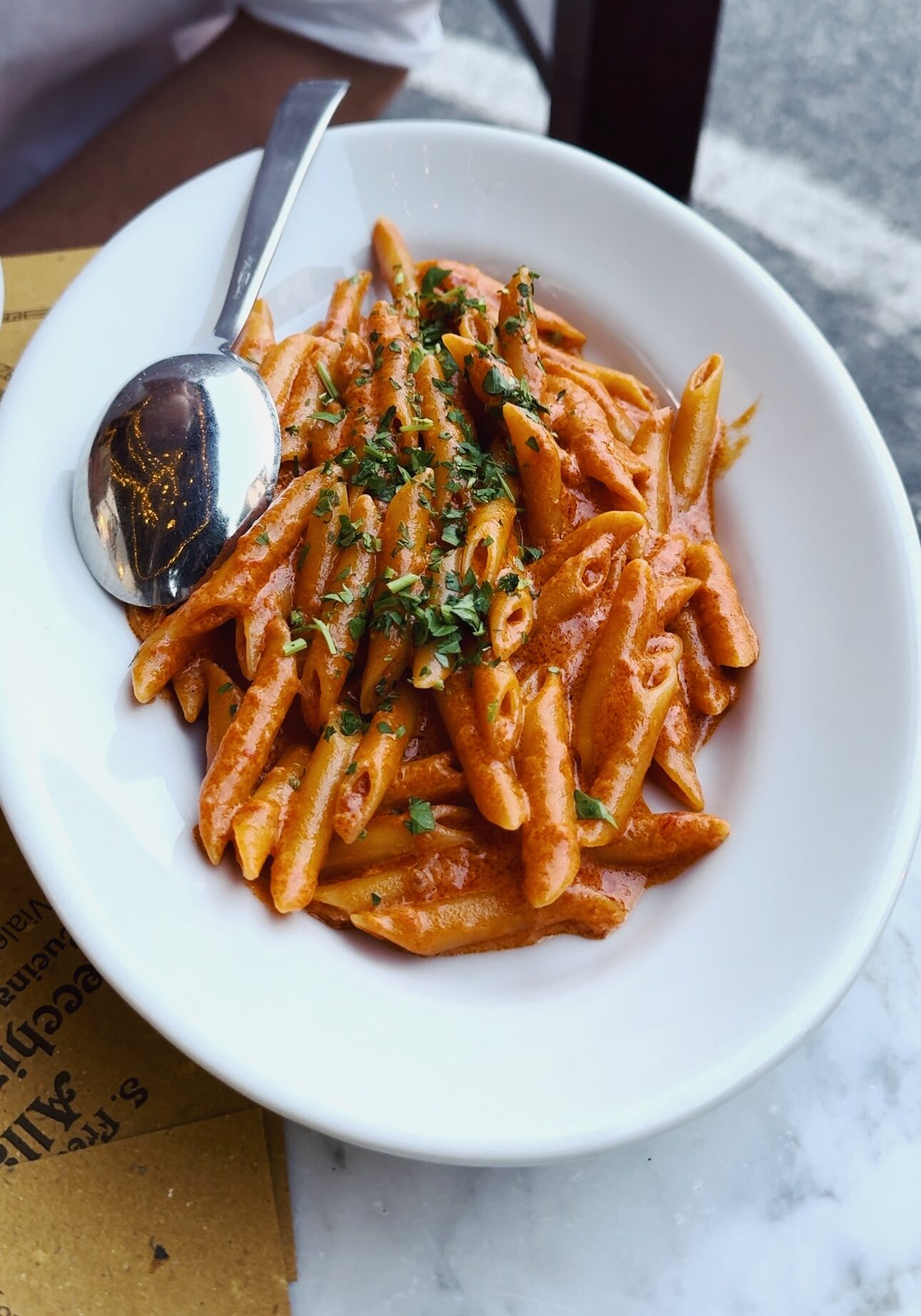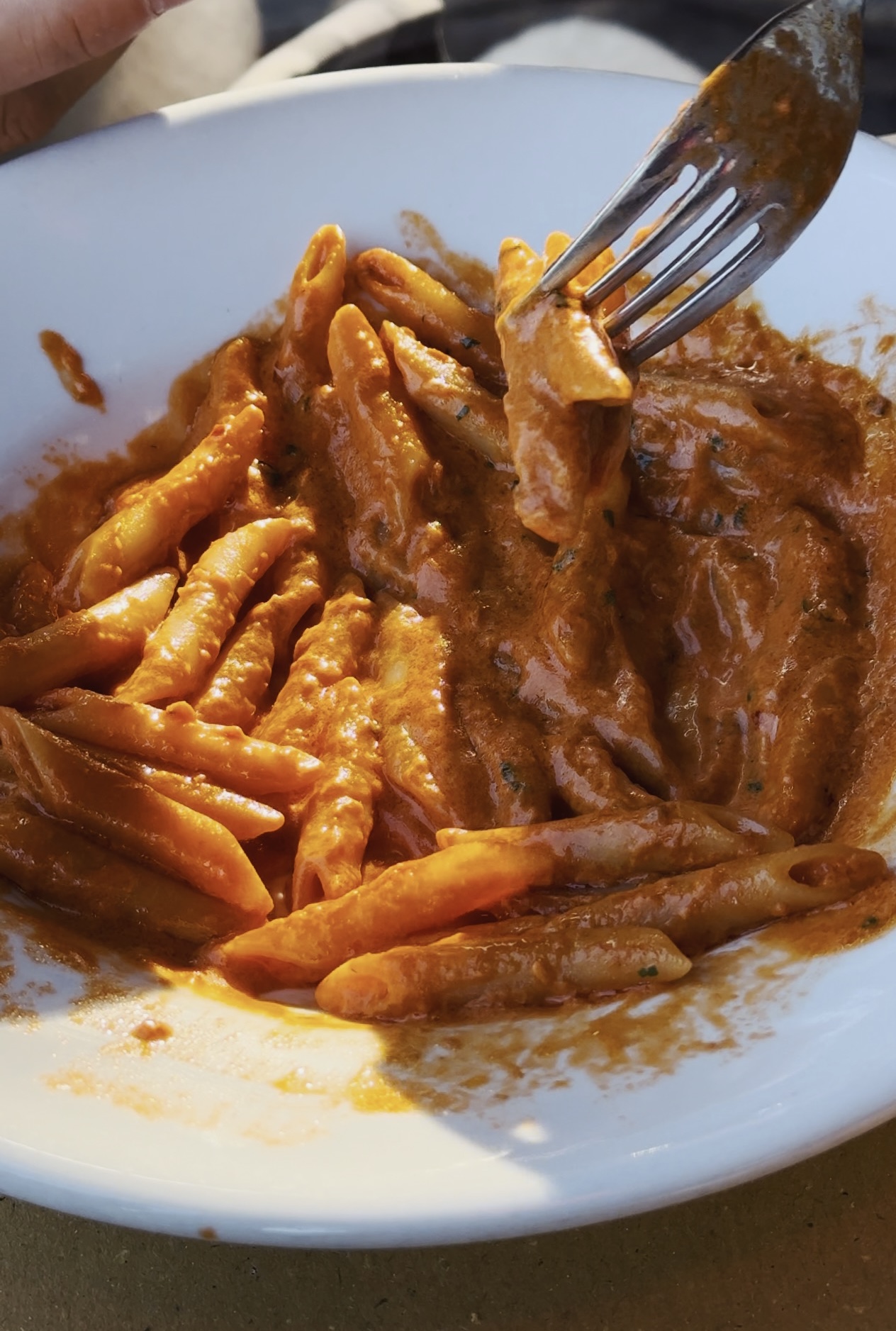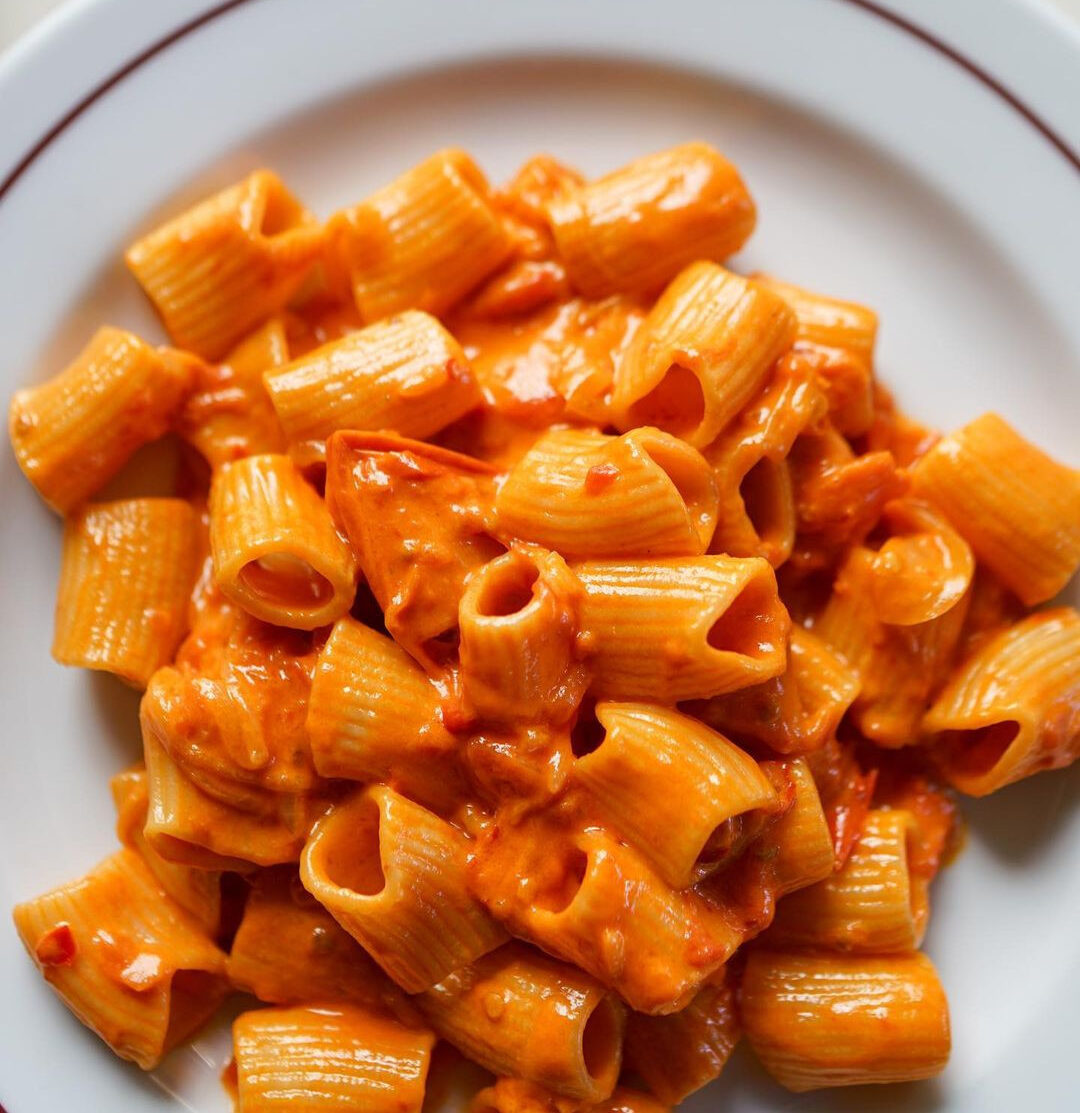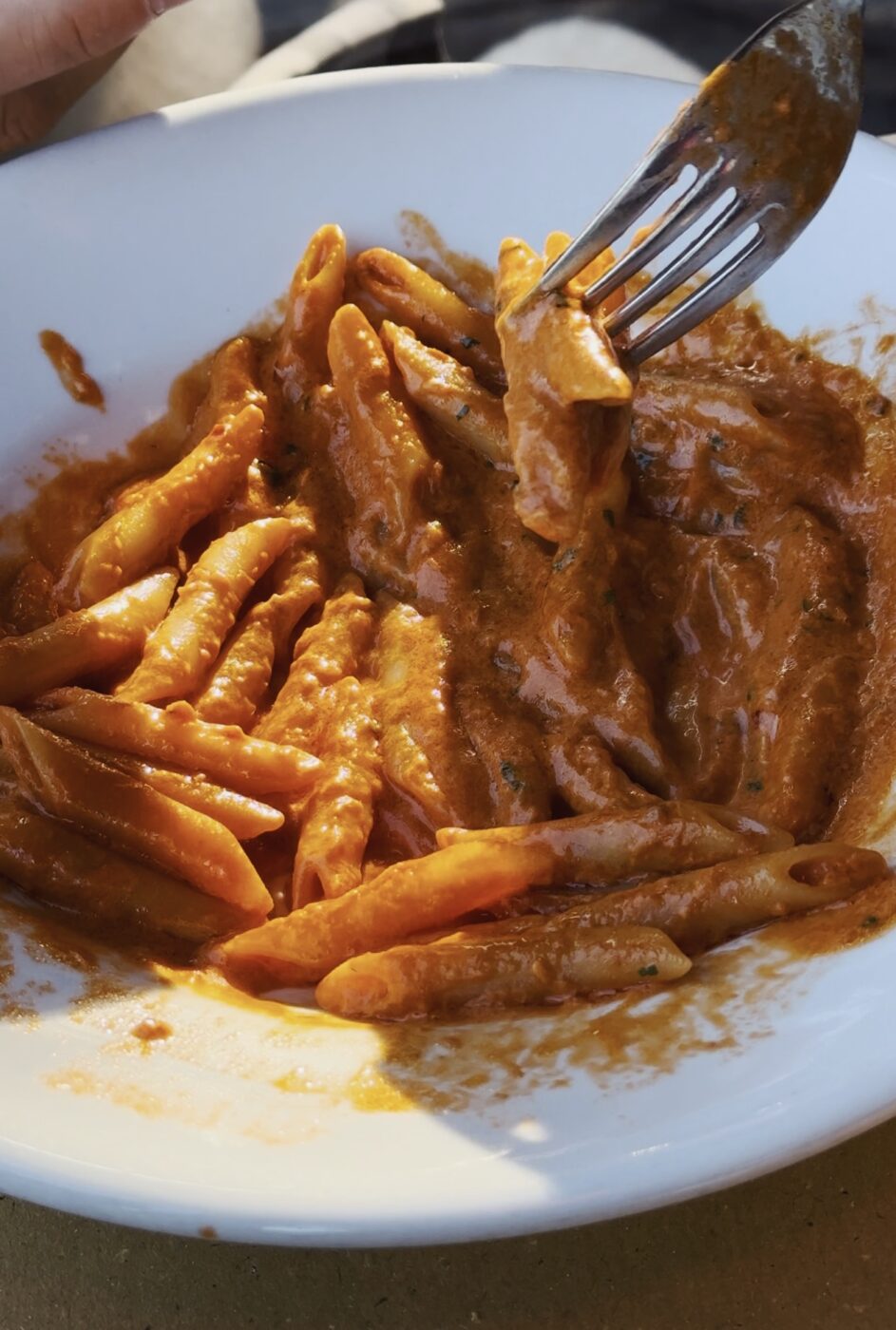I hear the words penne alla vodka and immediately I’m 12 years old again, sitting in the booth of my family’s favorite suburban Italian-American restaurant, a tacky trompe d’oeil “frescoed” ceiling overhead, wood paneled-walls all around, and the smell of fresh-baked ciabatta-style dinner rolls wafting through the air. The plaster columns by the door are more Grecian than Roman, Frank Sinatra plays on the tinny sound system, and the “parmesan” is from a shaker. I enthusiastically encourage the waiter to keep piling it on top of my overflowing plate, a portion size that will easily last me two more meals after this.
For so many North Americans (particularly those of us on the East Coast), the sauce that conjures up a vision of pure Italo-Americana is a rich, velvety, perennial crowd pleaser made from tomato paste, cream, and a splash of vodka. It’s a beloved fixture on Italian-American menus and you can find it jarred in every grocery shop. It’s continuously ranked as the second most popular pasta in America, falling just short of spaghetti alla bolognese (that’s a whole other discussion, emphatically not actually from Bologna).
Penne alla vodka is so ubiquitous in America–and so absent in any of Italy’s regional cuisines–that it never even dawned on me to fact check the origins of the dish. The dish that once left the corners of my mouth stained orange every Friday night slowly disappeared from my dietary repertoire, as I started favoring more “authentic” restaurants. I traveled to and eventually moved to Italy, and found myself laughing along when Italian classmates mocked Italian-American food. Without looking back, I tossed my first pasta love aside in favor of seductive, all-Italian lovers like Genovese and amatriciana.
So, it was with a pang of remorse that I recently discovered that penne alla vodka may, in fatti, be Italian. It also may be American*. Turns out, the history is a little murky.

La Vecchia Bettola, Florence
Theories from both sides of the Atlantic
Most widely accept that vodka sauce was invented in New York, in the 1980s. Theories trace its origins to one of two people: the first, James Doty, a grad student at Columbia who, in the spirit of collegiality, added a splash of vodka to his sauce. The second, with a very similar story, was Chef Luigi Franzese, of Orsini restaurant. His daughter substantiates his claims that, in a moment of DIY genius, he used a splash of vodka to thin a sauce he was making with cream and tomato pulp. He called his version penne alla Russa, in homage to vodka’s motherland. Evidently, more than one chef caught wise to the emulsifying properties of alcohol–wine has been used in this fashion for eons. But unlike wine, relatively tasteless vodka does the job without leaving any contaminating flavor behind.
On this side of the Atlantic, the sauce’s alleged roots can be traced back to an ambiguous chef’s kitchen in Rome and Dante Casari’s restaurant in Bologna, respectively, and both seem to predate the New York claims by a margin of a few years, having popped up in the late ‘70s or early ‘80s. Some even point to a restaurant in Florence, Alla Vecchia Bettola, that’s been serving the dish since the late ‘70s. On the menu as “Penne alla bettola”–no mention of a certain hard alcohol–the pasta has become somewhat of a legendary plate in the city, beloved by both locals and tourists alike.
If we’re looking to trust the written word, the first mention in text of vodka sauce was in Italian actor and chef Ugo Tognazzi’s cookbook memoir, l’Abbuffone, published in 1974. In it, he describes riffing on an arrabiata recipe by adding cream to mellow it, and a splash of vodka to help emulsify it. He called it pasta all’infuriata.
…And one from Japan
But to really get to the root of it, we may have to go to Osaka, Japan, and the World Expo of 1970. Italy was there, of course, flexing its engineering with the likes of an Olympic-winning bobsled and moto racer Giacomo Agostini’s legendary MV Agusta 500. Meanwhile, the 65-person pavilion kitchen, helmed by Rome’s it chef of the moment Mario Zorzetto, cranked out endless plates of crowd pleasers like tortellini, pizza, and supplì. According to Livio Jannattoni’s 1972 book “Osterie della vita e dell’amore”, the vibe at the Expo was far from friendly—except with the Russians. After hours, Zorzetto would cook spaghetti for their easterly neighbors, who would, fulfilling national stereotypes, bring vodka. One night, probably with a little too much of the latter later, the two got combined. Penne alla vodka was born.
Zorzetto, who had wooed all the big stars of the Dolce Vita era at his Café de Paris on Via Veneto, returned to Rome, played with the recipe, and featured it on the menu of his Taverna Giulia. Just a few years later, its climb to 1980s icon began–not in trattorias and restaurants, but in the discos of Rome. In those years, haute cuisine found a new home in nightclubs, and on a glittering night on the Eternal City, it wasn’t uncommon for revelers to frequent one-stop shops for music, dancing, and a gourmet meal. Soon, you couldn’t hit a club nor a restaurant without seeing penne alla vodka—often flamed tableside. Variants like penne al cognac and “alla moscovita” (with smoked salmon and caviar) followed in hot pursuit.

The Disco Sauce’s Simultaneous Rise and Fall
Maybe it was a curious tourist or an Italian chef who’d set up shop in New York–perhaps one of the aforementioned characters, if we can hope that these convoluted stories converge–that brought penne alla vodka across the Atlantic. The early reviews were far from flattering, with the New York Times calling it an “alcoholic Alfredo” in 1981. (For a people that loved alfredo and alcohol equally, this hardly seems like an insult, but vabbè.) Needless to say, penne alla vodka’s criticisms hardly hampered its success, and the people pleaser would go on to become the dish of late-night, post-club binges and white tablecloth table d’hotes alike throughout the ‘80s.
(The recently released, small-budget but big impression documentary, “Disco Sauce: The Unbelievable True Story of Penne Alla Vodka” digs further into the cultural significance of penne alla vodka to Italian-Americans and the sauce’s place in the landscape of the 1980s and 90s, a time of tumult in New York–see: Reagan, AIDS, the war on drugs, and eventual economic and cultural boom.)
And here is where we really get into the tension about this pasta, though, which comes not from Italy and the US fighting over who can stake claim to it, but rather, it would seem, the more popular it became in the US, the more Italy pretended to have nothing to do with it. (Both back then and in 2023, when model Gigi Hadid went viral for her spicy recipe.) Could it have been the very things that made penne alla vodka a hit in the US that made Italians ditch it within two decades?
Penne alla vodka was just too foreign to ever feel like a real national dish. And cream? By the turn of the millennium, Italians had declared it public enemy number one, banning it from every primo imaginable. Italians’ obsession with grounding every dish in some ancient cultural tradition left penne alla vodka out in the cold. The flame fueling its meteoric success spluttered out, and the pasta became, in Italy, a relic of the ‘80s–a symbol, and a kitschy one, of an era.
Perhaps, like the bonding nature of vodka itself (socially sure, but in this case, chemically), penne alla vodka has the ability to fuse two cultures, the greatest of equalizers–one that may have been born in Italy, but certainly grew up in the US. In the Carrie Bradshaw-est of ways, I can’t help but wonder if it matters where it’s from. Rather, I’m here to celebrate where it’s been.
*Again, at the end of the day, does it matter? I will forever be befuddled as to why we’re all so fixated on the inventors of recipes.






